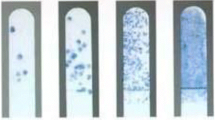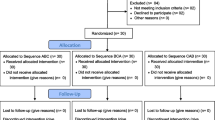Abstract
Aim:
The aim of this study is to reduce the caries risk in cleft lip and palate (CLP) patients with multibracket appliances via a compliance-independent method.
Patients, Materials and Methods:
Sixty-eight CLP patients with multibracket appliances were submitted to professional tooth cleaning at 4-week intervals. After randomization, patients in group A wore a splint filled with chlorhexidine (CHX) gel (Chlorhexamed®) for 15 minutes (3 × 5 min) every 12 weeks. Patients in group B were treated with CHX varnish (EC40®) every 12 weeks. Fluoride varnish (Fluoridin®) was applied to all teeth 4 and 8 weeks after the respective CHX treatments.
Regular salivary bacteria counts (CRT®) were carried out to determine therapeutic effectiveness. Initial DMFS values were compared to the final ones.
Results:
Initial findings of the salivary test and DMFS index confirmed the high caries risk. The DMFS value increased dramatically in both groups despite this systematic prophylaxis program. The bactericidal effect of both CHX preparations turned out to be markedly weaker than that described in the literature.
Conclusions:
Though the CHX and fluoride application had a limited effect (at least in this test population), one should keep in mind that it is precisely this population that requires very intensive prophylaxis, and that no antibacterial adjuvant is more effective than CHX. However, the application interval should be individually adapted to the bacteria count.
Zusammenfassung
Ziel:
Ziel der vorliegenden Studie ist es, das Kariesrisiko bei LKG-Spalt-Patienten mit Multibracketapparatur durch eine complianceunabhängige Methode zu senken.
Patienten, Materialien und Methoden:
Bei 68 LKG-Spalt-Patienten mit Multibracketapparaturen wurde in 4-wöchigem Abstand eine professionelle Zahnreinigung durchgeführt. Nach einer randomisierten Aufteilung erhielten die Patienten der Gruppe A alle 12 Wochen eine mit Chlorhexidin-(CHX-)Gel (Chlorhexamed®) gefüllte Trägerschiene, die für 15 Minuten (3 × 5 min) eingesetzt wurde. Patienten der Gruppe B wurden alle 12 Wochen mit CHX-Lack (EC40®) behandelt. Auf alle Zähne wurde 4 und 8 Wochen nach den jeweiligen CHX-Behandlungen Fluoridlack (Fluoridin®) aufgetragen.
Regelmäßige Speichelkeimzahlbestimmungen (CRT®) sollten Aufschluss über die therapeutische Wirksamkeit geben. Die anfangs erhobenen DMFS-Werte wurden mit den Endbefunden verglichen.
Ergebnisse:
Die Ausgangsbefunde der Speicheltests und des DMFS-Index bestätigten das hohe Kariesrisiko. Trotz dieses konsequenten Prophylaxeprogramms nahm der DMFS-Wert in beiden Gruppen dramatisch zu. Der bakterizide Effekt beider CHX-Präparate fiel deutlich geringer aus, als dies in der Literatur beschrieben ist.
Schlussfolgerungen:
Trotz dieser, zumindest bei dieser Untersuchungsklientel, geringen Wirkung ist an der CHX- und Fluorid-Anwendung festzuhalten, zum einen da es genau diese Klientel ist, die besonders intensiver Prophylaxe bedarf. Zum anderen gibt es keine wirksameren antibakteriell wirkenden Adjuvanzien als CHX. Allerdings sollte das Applikationsintervall individuell an die Bakterienzahl angepasst werden.
Similar content being viewed by others
Author information
Authors and Affiliations
Corresponding author
Rights and permissions
About this article
Cite this article
Weiß, M., Weiß, J., Müller-Hartwich, R. et al. Chlorhexidine in Cleft Lip and Palate Patients with Multibracket Appliances. J Orofac Orthop 66, 349–362 (2005). https://doi.org/10.1007/s00056-005-0508-2
Received:
Accepted:
Issue Date:
DOI: https://doi.org/10.1007/s00056-005-0508-2




